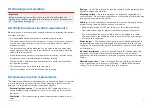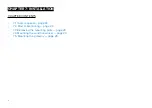
Important:
Observe the recommended fuse / breaker ratings provided in the product’s
documentation, however be aware that the suitable fuse / breaker rating is
dependent on the number of devices being connected.
Implementation — direct connection to battery
• Where connection to a power distribution panel is not possible, the power
cable may be connected to the vessel's battery.
• You MUST fit a 5 A inline fuse between the red wire and the battery’s
positive terminal.
• If you need to extend the length of the power cable, ensure you use
suitably rated cable and that sufficient power (12 V dc) is available at the
SeaTalkng ® backbone’s power connection.
1.
Waterproof fuse holder with 5 A inline fuse must be fitted (not supplied).
2. SeaTalkng ® power cable.
3.
Connection point for drain wire.
Battery connection scenario A:
Suitable for a vessel with a common RF ground point. In this scenario, the
power cable’s drain wire should be connected to the vessel’s common RF
ground point.
Battery connection scenario B:
Suitable for a vessel without a common RF ground point. In this scenario
the power cable’s drain wire should be connected directly to the battery’s
negative terminal.
SeaTalkng ® Power cable extension
If you need to extend the length of the SeaTalkng ® power cable, ensure
you use suitably rated cable and that sufficient power is available at the
SeaTalkng ® backbone’s power connection point:
• For power cable extensions, a
minimum
wire gauge of 16 AWG (1.31 mm
2
)
is recommended. For cable runs longer than 15 meters, you may need to
consider a thicker wire gauge (e.g. 14 AWG (2.08 mm
2
), or 12 AWG (3.31
mm
2
) ).
• To ensure power cables (including any extension) are of a sufficient gauge,
ensure that there is a continuous
minimum
voltage of
10.8 V dc
at the
end of the cable where it enters the product’s power connector, even
with a fully flat battery at 11 V dc. (Do not assume that a flat battery is at
0 V dc. Due to the discharge profile and internal chemistry of batteries,
the current drops much faster than the voltage. A “fully flat” battery still
shows a positive voltage, even if it doesn’t have enough current to power
your device.)
Important:
Be aware that some products in your system (such as sonar modules)
can create voltage peaks at certain times, which may impact the voltage
available to other products during the peaks.
More information
It is recommended that best practice is observed in all vessel electrical
installations, as detailed in the following standards:
• BMEA Code of Practice for Electrical and Electronic Installations in Boats
34
Summary of Contents for RSW-Wired
Page 2: ......
Page 4: ......
Page 16: ...CHAPTER 4 PARTS SUPPLIED CHAPTER CONTENTS 4 1 Parts supplied page 17 16...
Page 36: ...CHAPTER 10 GROUND CONNECTION CHAPTER CONTENTS 10 1 Gateway ground connection page 37 36...
Page 45: ...CHAPTER 13 MAINTENANCE CHAPTER CONTENTS 13 1 Service and maintenance page 46 Maintenance 45...
Page 68: ......
Page 71: ...WEEE Directive 8 What s in the box 17 Wind transducer Configuration 42 44 Wire stripping 39...
Page 72: ......
Page 73: ......






























